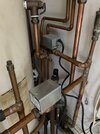Hi All
Background: DHW is not hot anymore. My boiler engineer can come on coming Wednesday. Tried to contact local heating engineers. 3 of them said that they are fully booked over the weekend and the earliest appointment is Tuesday. I have two young children and moaning Mrs and getting constant pressure to get it changed for the sake of the kids.
Can I pick your brain?
We have a system boiler Vaillant Eco Tec 630 plus and connected to Hive. Things have been perfect however, DHW is cold now.
I have ruled out Hive (as it turns on DHW light) but the boiler is not turning on. The boiler is new and only 4 months old.
That leaves the Honeywell Motorised valve as a culprit. I have moved it to manual and then auto a few times and that alone turned on the boiler (while the hive booster for HW is on). However, after a few minutes boiler turn off. I have turned the valve to manual position and the boiler is not kicking in now.
I have concluded that it's Honeywell motorised valve (22mm). I have gone to a local plumbing shop and bought a new one.
My abilities:
I can drain radiators, refill, bleed and work out any minor issues.
I have worked out the wiring of the Motorised valve and confident in changing it (I installed Hive myself).
New valve is exactly the same as old so hopefully, no extra work is required.
My questions:
-Looking at the pipework, the pipe from DHW Honeywell valve is going to CH valve as well. If I switch off the boiler / whole heating system, that means the CH valve will be closed. Do I need to empty radiators? Or considering the above, I can change the valve after I empty DHW pipework.
Will appreciate any help/pointers in the right direction.
PS: Pipework is shown in the photo. The valve which is closer to us is DHW valve and other one is for CH. Immersion tank heating filament is faulty (that is what I have been told).
Background: DHW is not hot anymore. My boiler engineer can come on coming Wednesday. Tried to contact local heating engineers. 3 of them said that they are fully booked over the weekend and the earliest appointment is Tuesday. I have two young children and moaning Mrs and getting constant pressure to get it changed for the sake of the kids.
Can I pick your brain?
We have a system boiler Vaillant Eco Tec 630 plus and connected to Hive. Things have been perfect however, DHW is cold now.
I have ruled out Hive (as it turns on DHW light) but the boiler is not turning on. The boiler is new and only 4 months old.
That leaves the Honeywell Motorised valve as a culprit. I have moved it to manual and then auto a few times and that alone turned on the boiler (while the hive booster for HW is on). However, after a few minutes boiler turn off. I have turned the valve to manual position and the boiler is not kicking in now.
I have concluded that it's Honeywell motorised valve (22mm). I have gone to a local plumbing shop and bought a new one.
My abilities:
I can drain radiators, refill, bleed and work out any minor issues.
I have worked out the wiring of the Motorised valve and confident in changing it (I installed Hive myself).
New valve is exactly the same as old so hopefully, no extra work is required.
My questions:
-Looking at the pipework, the pipe from DHW Honeywell valve is going to CH valve as well. If I switch off the boiler / whole heating system, that means the CH valve will be closed. Do I need to empty radiators? Or considering the above, I can change the valve after I empty DHW pipework.
Will appreciate any help/pointers in the right direction.
PS: Pipework is shown in the photo. The valve which is closer to us is DHW valve and other one is for CH. Immersion tank heating filament is faulty (that is what I have been told).
Attachments
Last edited:


